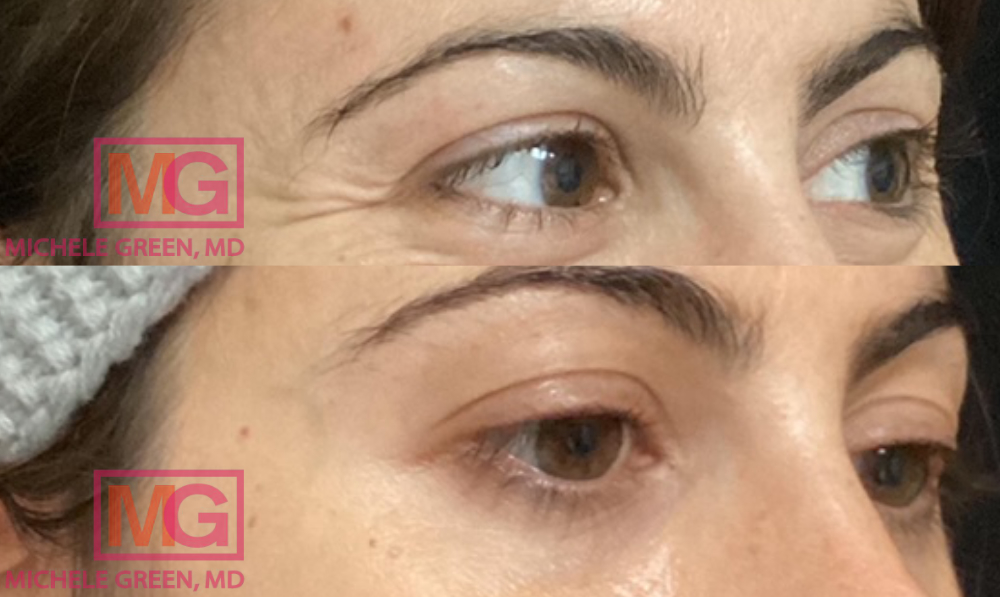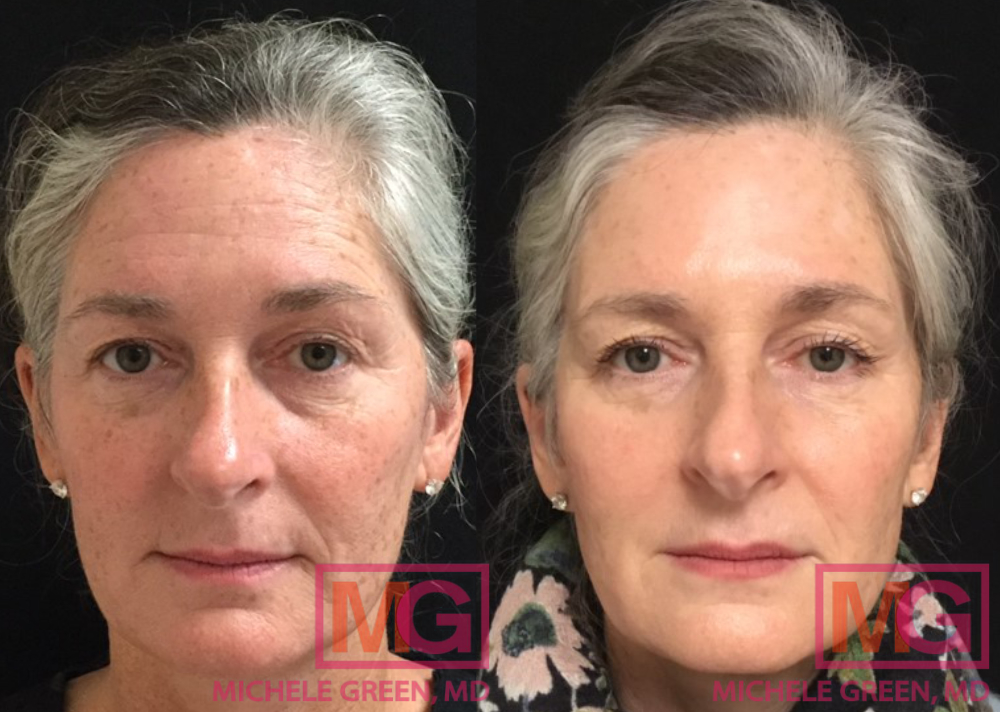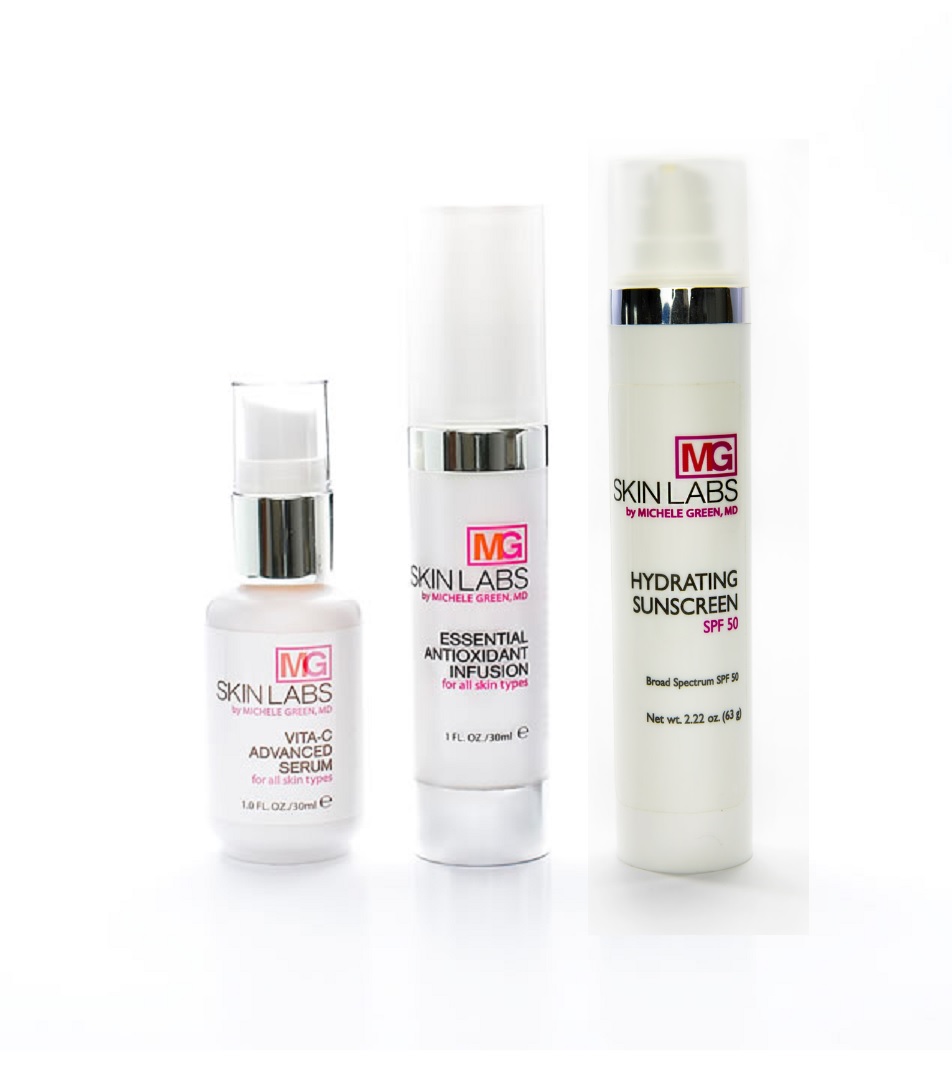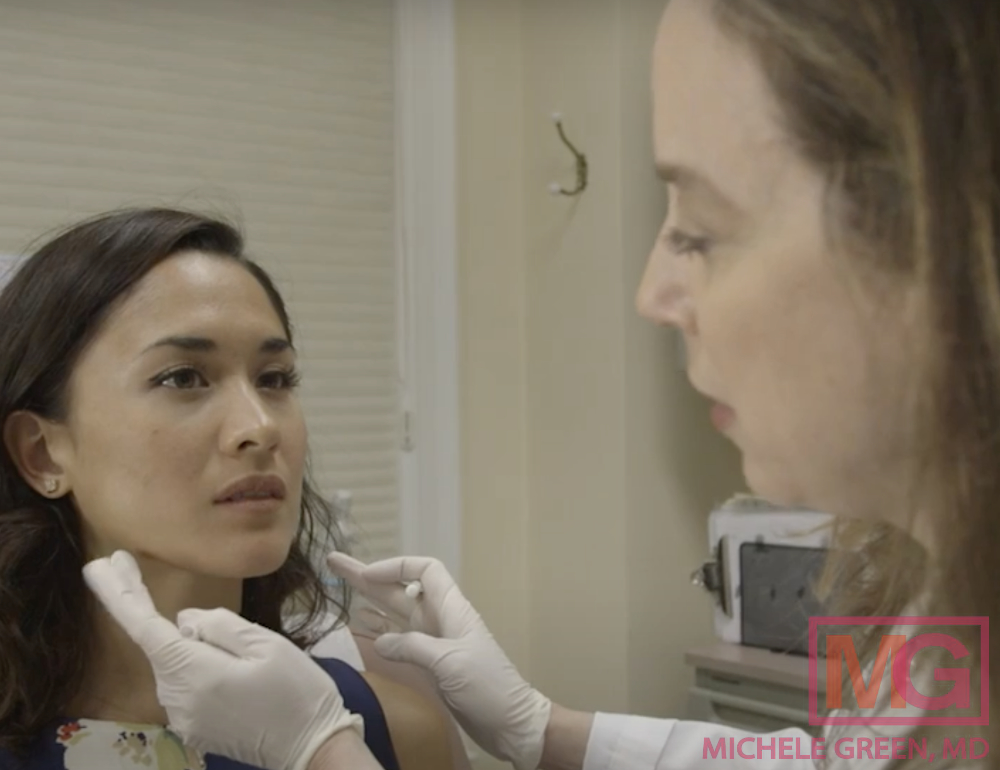What is Botox Bee Venom & Does It Work?
As we age, the levels of collagen and elastin naturally decrease, resulting in fine lines, wrinkles, and loose, sagging skin. Dynamic wrinkles form from repetitive facial expressions, becoming permanently etched into the skin over time. To enhance the appearance of dynamic wrinkles, many patients opt for standard Botox treatment, which involves injecting botulinum toxin type A into the facial muscles to essentially “freeze” them, leading to a smoother skin texture and a more youthful complexion. Botox bee venom is a new skincare product believed to provide effects similar to the popular cosmetic procedure Botox. When performed by an experienced dermatologist, such as Dr. Green, Botox injections are a safe and effective aesthetic treatment for achieving a naturally youthful appearance with minimal downtime.
Botox remains the most popular cosmetic procedure due to its remarkable results, minimal side effects, and lack of downtime. The active component, botulinum toxin, blocks communication between nerves and muscles, causing muscles to become “frozen” from Botox injections. Repeated facial expressions can cause the skin to fold, leading to wrinkles that may become permanently etched in, resulting in fine lines and deeper wrinkles. However, some patients prefer to avoid injectable treatments and instead utilize topical skincare products. While bee venom is often assumed to contain only harmful substances, it actually includes many beneficial components, such as melittin, which can enhance skin quality. Botox bee venom is believed to harness these beneficial ingredients within bee venom to improve visible signs of aging without the need for injections.
Dr. Michele Green is an internationally renowned, board-certified dermatologist with over 25 years of experience providing innovative, non-invasive cosmetic treatments to some of the world’s most discerning individuals, including Botox, dermal fillers, and more. Dr. Green was among the first dermatologists in NYC to offer cosmetic Botox injections, embracing a “less-is-more” philosophy regarding facial rejuvenation treatments. This approach emphasizes enhancing natural beauty and achieving beautiful, natural-looking results. Consistently recognized as one of NYC’s top dermatologists by Castle Connolly, New York Magazine, Super Doctors, and The New York Times, Dr. Green possesses the knowledge and expertise necessary to deliver Botox injections for pan-facial rejuvenation.
What is Botox?
Botox is a brand name for botulinum toxin, developed for various medical and cosmetic uses. It first received FDA approval in 1991 and has become the gold standard for treating dynamic wrinkles. The main ingredient in these injectable treatments, botulinum toxin type A, is produced by the bacterium that causes botulism. When purified and administered in the appropriate dose, botulinum toxin type A effectively prevents and corrects fine lines and wrinkles caused by repetitive facial expressions. Botox is injected into specific facial muscles that create wrinkles, such as frown lines, crow’s feet around the eyes, and forehead lines. The neurotoxin in botulinum toxin works at the neuromuscular junction by blocking nerve signals. As a result, the muscles are essentially “frozen” by the Botox injections and can no longer contract. When the muscles cannot contract, wrinkles stop forming and can even soften over time. The cosmetic results from Botox are long-lasting but temporary, typically persisting for three to four months.
What is Botox bee venom?
Botox bee venom refers to a topical skincare product that claims to deliver the same cosmetic effects as Botox. Various brands have developed face creams and face masks infused with bee venom, promoting them as offering results comparable to those of Botox. The key ingredient in this topical product is bee venom, also known as apitoxin. Many people associate bee venom with bee stings and allergic reactions rather than with anti-aging benefits. While bee venom is noted for its inflammatory properties, research shows that some components actually have anti-inflammatory effects and can even provide anti-aging advantages. Melittin, a peptide that constitutes the main component of bee venom, accounts for up to 50% of its weight and possesses anti-microbial, anti-viral, and anti-inflammatory properties. Research also suggests that melittin may stimulate collagen production and improve skin texture. By encouraging collagen and elastin production, bee venom supports cell repair and skin cell turnover, resulting in a more youthful appearance.
Is Botox bee venom?
No, Botox is not bee venom. Botox is an injectable drug containing the active ingredient botulinum toxin type A (onabotulinumtoxina) and the inactive ingredients human albumin and sodium chloride. Botulinum toxin type A is a protein derived from and purified from the bacterium Clostridium botulinum. Human albumin and sodium chloride stabilize the botulinum toxin, protecting it during manufacturing, storage, and administration. When injected into different muscles, Botox works at the neuromuscular junction to block nerve signals. This can help prevent and reduce dynamic wrinkles that develop from repetitive expressions and muscle contractions.

Is bee venom a neurotoxin?
Bee venom contains various chemicals and substances that lead to localized reactions after a bee sting. One of its components is the peptide apamin, which acts as a neurotoxin. Apamin selectively blocks certain potassium channels in neuron cells commonly found in the central nervous system. When apamin interacts with neurons, it can induce hyperactivity in the spinal cord, convulsions, and affect smooth muscle contractions and acetylcholine release. While bee venom can cause serious adverse reactions in the central nervous system, a bee sting is usually localized, with the venom remaining at or near the injection site throughout the process.
Does Botox bee venom work?
Before purchasing a bee venom product, it’s important to assess whether the product is safe and effective. Given that bee venom products often carry a high sale price, many patients wish to determine if it will be a waste of money before making a purchase. Although some research suggests that topical bee venom may be beneficial for treating wrinkles, further investigation is needed to understand its effectiveness and potential risks. Bee venom can trigger an immune response in the skin, leading to increased blood flow and collagen production, which can plump and smooth the skin. However, bee venom might also cause allergic reactions and other adverse effects.
Is Botox bee venom safe to use on the face?
The answer is maybe. Bee venom is known to cause allergic reactions in many people. Individuals with a known bee allergy should avoid using bee venom products because they may experience a severe, systemic allergic reaction (anaphylaxis) if they use Botox bee venom. Many people who use bee venom creams report localized side effects such as dry skin, rashes, and redness afterwards. Those without a known bee allergy should perform a test spot before applying bee venom moisturizing cream everywhere. Bee venom contains multiple skin irritants, so performing a small test spot will prevent an adverse reaction across the entire face.

What skincare is best for anti-aging?
Internationally renowned Dr. Michele Green has developed a proprietary line of skincare products, MGSKINLAB Inc., which includes gentle yet effective products to provide patients with a smooth, even complexion that lasts.
Vitamin C serum is one of the best products for individuals of all skin types and tones. It serves as an antioxidant, protecting the skin from sun damage by neutralizing free radicals generated by UV radiation and helping to combat oxidative stress, which can lead to premature aging. Additionally, Vitamin C promotes skin regeneration and collagen production, enhancing both texture and tone. It also helps fade hyperpigmentation, brighten the skin, and support cellular repair. MGSKINLAB’s Vita C serum is an excellent choice, containing a high concentration of Vitamin C to improve skin texture and tone, resulting in a more even complexion.
The AM/PM Duo serum (2pc) from MGSKINLABs includes two anti-aging serums that work synergistically to combat premature aging. The AM serum protects against damage from environmental stressors with its antioxidants and promotes cell renewal with botanical enzymes. The PM serum features GGA, a compound proven to extend a skin cell’s lifespan by an impressive 33%, encouraging the health of skin cells. Together, the Duo serums address all signs of skin aging, including sagging, enlarged pores, roughness, redness, pigmentation, and fine lines and wrinkles.
Retinol is found in various over-the-counter skincare products, promoting skin cell turnover and boosting collagen production, resulting in an overall smoother, more even-toned complexion. Derived from vitamin A, it provides several significant anti-aging benefits, such as reducing the appearance of fine lines and wrinkles, firming the skin, unclogging pores, decreasing sebum production for acne treatment, fading dark spots and hyperpigmentation, and enhancing skin cell turnover. Dr. Green’s Essential Antioxidant Infusion harnesses the anti-aging benefits of retinol to achieve smoother, clearer skin.
Sunscreen is a crucial part of any skincare routine. MGSKINLABS Hydrating SPF 50 uses zinc oxide to create a protective barrier on the skin against UV rays, along with lactic acid and hyaluronic acid to soften and hydrate the skin. Physical sunscreens, like the Hydrating SPF 50, utilize zinc oxide or titanium dioxide to block UV rays from penetrating the skin and causing photoaging. This type of sunscreen is the perfect choice for those who want to simplify their skincare routine, keep their skin healthy and moisturized, and guard against UVA and UVB rays that contribute to skin cancer and premature aging.

Botox Bee Venom FAQs
Does bee venom work like Botox?
While bee venom contains neurotoxins like Botox, topical bee venom provides unique benefits for the skin when compared to Botox. Topical bee venom is believed to stimulate the body’s natural healing responses in the skin, potentially improving skin tone, texture, and the appearance of wrinkles. It is thought to achieve this by increasing blood flow to the area, delivering oxygen and nutrients, and promoting the production of collagen and elastin. Botox, on the other hand, is the gold standard for treating dynamic wrinkles and fine lines. The injectable treatment acts at the neuromuscular junction to reduce muscle activity, effectively “freezing” the muscles. This blocks dynamic wrinkles that appear during facial expressions from becoming permanently etched in the skin. Results from Botox generally last three to four months, leading many patients to receive Botox touch-ups throughout the year to maintain their smooth, wrinkle-free skin.
Does extracting bee venom kill the bee?
No. Modern methods can extract bee venom without harming the bees. A bee will die if its stinger is removed from its body while stinging something. Historically, to extract bee venom, beekeepers would crush the bees or make them sting surfaces that trapped their stingers. Nowadays, beekeepers utilize fabric-covered plates with flat conductor wires arranged across them. The wires emit a gentle electric current that shocks the bees when they land on the plate. This current shocks the bees enough to prompt them to release their venom without dislodging the stinger, allowing them to survive.
Why is bee venom good for your skin?
Bee venom contains more than 20 different substances, and research suggests that some of them can benefit the skin. Melittin, a component of bee venom, is thought to enhance skin health by promoting collagen production, reducing inflammation, and improving skin texture. Collagen is a crucial structural protein in the skin that naturally decreases with age. Boosting collagen production can help address various signs of aging, including fine lines, wrinkles, and loose, sagging skin. Although bee venom may offer anti-aging benefits, more research is needed to determine the true effectiveness of topical bee venom.
Is Botox bee venom legit?
The answer is maybe. Bee venom facial creams and serums have gained popularity in recent years as a “natural” alternative to Botox and other anti-aging procedures. Companies that produce these creams claim that the amino acids and other ingredients provide anti-aging benefits, such as smoothing wrinkles, plumping the skin, and even offering an instant facelift. However, limited research has been conducted to support these claims. More clinical studies are needed to determine the effectiveness of bee venom compared to Botox. Additionally, many of these products claim to be organic and contain organic ingredients. The only way to ensure a product is truly organic is by looking for the USDA Organic label. This label indicates that the product has undergone rigorous review to conform to organic practices.
How long does it take for Botox bee venom to work?
Botox, bee venom serums, and products are applied topically to the skin, which takes time to become effective. Results from these topical products typically require consistent use for at least a month before they are visible. Stimulating and producing collagen takes time. Some people may notice a temporary improvement within a few minutes of applying the product, as the bee venom plumps the skin by increasing blood flow to the area. Long-term benefits from topical bee venom will require several weeks of consistent use to become apparent.
What is a natural Botox alternative?
Some patients are interested in achieving a more youthful appearance but prefer to pursue natural options instead of injectable treatments like Botox. While nothing can replicate the exact results of Botox, a good skincare routine with the right mix of ingredients can minimize the appearance of fine lines and wrinkles. Retinols are among the most effective anti-aging topical products. They promote skin cell turnover, sloughing off dull, damaged skin cells and revealing the fresh, healthy skin cells beneath. Retinols also stimulate collagen production, resulting in smoother, firmer skin. In addition to retinol, sunscreen is one of the most essential skincare products. Photoaging refers to the premature aging of the skin caused by UV radiation from sunlight. To prevent photoaging, patients should apply sunscreen with an SPF of at least 30 every day, and when outdoors in the sun, they should reapply sunscreen every 90 minutes. Regular sunscreen application can help slow the onset of fine lines and wrinkles, offering a natural alternative to Botox.
Where can I buy Botox bee venom?
Botox bee venom is available over the counter in the form of creams, serums, and face masks. Many small brands sell bee venom skincare products on Amazon and other sites, in addition to various supplements and items marketed as natural or organic. Before purchasing any skincare products, it is essential to research and buy only from reputable sources. Many skincare products are labeled as cosmetic products and are not directly regulated by the FDA; therefore, some may not be safe, potentially causing more harm than good. If you are ever unsure about which skincare products to use, you should consult a board-certified dermatologist, such as Dr. Green, who can guide you toward the products that are best for you.
Can you get Botox if you are allergic to bees?
Yes, Botox injections do not contain any ingredients derived from bee venom. Bee venom includes common allergens that stimulate a histamine response in the body, such as hives, difficulty breathing, and even anaphylaxis. Luckily, patients interested in Botox injections do not need to worry about being allergic to bees, as Botox is completely separate from bee venom. The active ingredient in Botox is derived from a bacterium called Clostridium botulinum. Patients who have allergic reactions to Botox or any other neuromodulator products should avoid receiving any additional injections. When you consult with Dr. Green about Botox injections, she will review your full medical history, including any allergies, before performing any treatments.

How to get started with Botox today?
If you’re frustrated by the sight of fine lines and wrinkles on your face, Botox may be right for you. Botox is the gold standard for treating and preventing dynamic fine lines and wrinkles. It’s one of the most popular non-invasive cosmetic treatments worldwide, thanks to the ease of injections, minimal downtime, and consistently impressive results. Some patients prefer to avoid injectable treatments and seek beneficial skincare products instead. Finding the right products for your unique skin concerns can be challenging on your own. For guidance on selecting the best skincare products for you, including Botox and bee venom, schedule a consultation with New York City-based dermatologist Dr. Michele Green.
Dr. Michele Green is an internationally renowned, board-certified dermatologist with over two and a half decades of experience providing her patients with the best non-invasive treatment options. Dr. Green takes a holistic approach, embracing a less-is-more philosophy, and creates customized skincare routines and treatment plans that address the unique concerns and aesthetic goals of her patients. She is consistently recognized as one of New York’s best dermatologists by Castle Connolly, New York Magazine, and Super Doctors for her dedication to her patients and expertise. Please call us at 212-535-3088 or email our New York City-based office today to schedule a consultation with Dr. Michele Green and discover if Botox injections are right for you.
 212-535-3088
212-535-3088